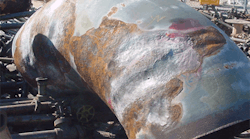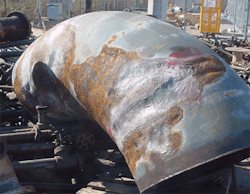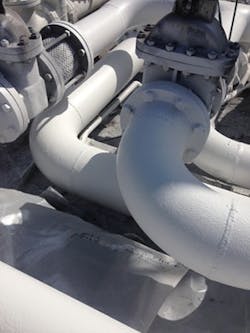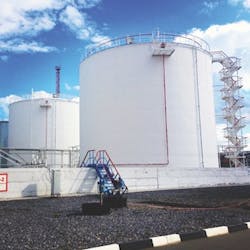Personal Safety: Consider Thermal Insulative Coatings
Protecting personnel from burns on hot, exposed surfaces is a top priority for process plant safety.
All it takes for skin to blister and burn is a few seconds of incidental contact with a hot surface. The U.S. Occupational Safety and Health Administration (OSHA) sets a limit of a maximum skin temperature of 140°F (60°C) after five seconds of exposure. By definition, no reportable injury will occur at this skin temperature and exposure time.
The external surfaces of process piping, ductwork, storage tanks and other equipment throughout a plant can reach temperatures well above the OSHA guideline for incidental skin contact. Systems with external surface temperatures greater than OSHA’s threshold pose a major hazard to workers’ and visitors’ safety — so plants must take steps to mitigate burn potential.
In some situations, plants can erect safety cages and fencing to keep people away from hot surfaces. More often, though, sites must insulate surfaces to ensure their temperature does not exceed the limit.
Process plants have two primary options for insulating hot, exposed surfaces for burn protection: the traditional method of covering surfaces with insulation and cladding or the emerging method of applying thermal insulative coatings. Both options enable plants to meet OSHA’s burn protection guidelines — but they differ in their cost, installation, maintenance, corrosion potential and insulation values.
Figure 1. Removal of a traditional insulation and cladding system revealed that CUI had eaten away at the surface of this process pipe.
Traditional systems typically feature insulation materials covered with a metal cladding to protect the insulation. These bulky systems do the job of mitigating burn potential and also offer high insulation values, especially when first applied. However, they’re prone to water infiltration, which significantly reduces their insulating properties. Worse yet, that water infiltration may cause corrosion under insulation (CUI), a hidden and costly threat to plant safety and reliability (Figure 1).
In contrast, thermal insulative coatings are spray-applied to exposed surfaces and don’t require cladding to mitigate burn potential (Figure 2). The coatings can be used almost anywhere that traditional insulation systems are. Just a few simple-to-apply layers of material make the coated surfaces safe to touch. By obviating metal cladding, the coatings also completely eliminate the threat of hidden CUI.
The coatings contain ceramic microspheres — small beads filled with air — that create a high air content in the final dried coating surface. This air acts as an ideal insulator, limiting the transfer of heat energy through the coating so exterior surfaces remain safe to touch for at least the OSHA-mandated 5-sec threshold. Even dangerously hot systems like steam piping and boiler ductwork may be coated to prevent burns to personnel.
Because many plants aren’t familiar with thermal insulative coatings, this article compares such coatings to traditional insulation systems and provides some pointers for deciding on an appropriate insulation system.
Key Differences
Although they offer similar capabilities for burn protection, traditional insulation systems and thermal insulative coatings differ significantly in their application and maintenance requirements — particularly in terms of plant downtime and inspection.
Downtime. To apply traditional insulation systems, plants typically must shut down operations that produce heat in the process areas being insulated. Once surfaces are cool enough, workers must remove and discard the old insulation, inspect all areas for surface corrosion, potentially abrasive blast and coat any areas that have corroded, and then rewrap the entire area with insulation and cladding. The procedure is time consuming, especially for fitting bulky insulation around curves, tight spaces and valves.
In contrast, applying thermal insulative coatings may not require shutting down any processes. Advanced single-component, waterborne acrylic insulative coatings can be put on surfaces with temperatures from ambient up to 350°F (177°C).
Maintenance staff can apply the coatings to a prepared and primed surface or directly to an intact, existing coating — so long as it’s tightly adhered, sound and compatible with the insulative coating. To ensure compatibility, personnel may need to test the coating for adhesion. They also must remove any dirt, grease and other contaminants using solvents or an abrasive sweep blast prior to putting on the coating. During application, staff must limit overspraying coatings onto surrounding equipment and surfaces, particularly in hazardous or confined areas. Sensitive components may require covering to protect from overspray. Using coatings with short dryfall distances can help minimize overspray concerns.
Each coat is approximately 20-mils thick. The number of coats required depends on the operating temperature of the substrate — for example, two to three coats may suffice for systems operating at up to 250°F (121°C) but systems reaching temperatures as high as 350°F (177°C) may need as many as five coats to ensure surface temperatures are below OSHA’s skin-contact threshold. (Confirm the OSHA compliance of the insulative coating system in the laboratory using a thermesthesiometer. A traditional surface temperature probe will not provide an accurate reading of skin temperature.) Substrates with temperatures above 350°F (177°C) exceed the temperature resistance of the acrylic resin and will require a conventional insulation and cladding system.
Figure 2. A spray-applied coating system helps minimize burn hazards as well as maintain the internal temperature of this crude oil pipeline that operates at 180°–200°F.
Inspection. Traditional insulation systems hide metal surfaces from view and have a void space prone to moisture infiltration. So, CUI is a major concern and these systems are subject to CUI protocols that mandate visibly inspecting the surface of the metal. Some process vessel, tank and piping inspections also require ultrasonic testing to assess the metal thickness and monitor for internal corrosion. To conduct either or both of these inspections, personnel must remove some insulation material and cladding or install inspection ports to permit easy access to the metal surface. Both actions increase the likelihood that water or moisture vapor will penetrate the metal cladding.
It is possible to mitigate CUI concerns when using a traditional insulation system by applying a specially designed CUI-resistant coating to the insulated substrate. Moisture still may become trapped against metal surfaces but the coating is formulated for immersion service in the chemical-laden water that is present, so the metal surfaces will resist corrosion.
Opting for thermal insulative coatings eliminates the risk of CUI altogether because the coatings don’t trap moisture against metal surfaces — and actually create a barrier to prevent moisture and condensation from contacting the metal substrate. The external surfaces of assets protected by thermal insulative coatings remain exposed and don’t fall under CUI inspection protocols. They simply require periodic visual inspection as dictated by the plant’s maintenance schedule to ensure the coatings are intact and still providing corrosion protection to the substrate. Unlike inspections for conventional insulation and cladding, coatings inspections are very fast and inexpensive to conduct.
Coated surfaces still will require periodic touchups. Abrasions, nicks and exposure to chemicals all can compromise the coating’s performance. Plants can expect an insulative coating to last anywhere from 10 to 20 years depending on the extent of such elements.
Insulation Values
Maintaining the designed process temperature inside piping and vessels to minimize a plant’s energy consumption and ensure process flow requires some form of insulation.
Traditional insulation systems can provide high insulation R-values when first installed. However, these systems typically lose a significant portion of their stated R-value shortly thereafter. This drop stems from infiltration into the insulation material of water or water vapor, which displaces the air content that initially had provided the stated R-value. Laboratory testing at 160°F (70°C) has shown that typical mineral-wool insulation material will lose up to 85% of its R-value when water is present at 10% by volume. In addition, conventional insulation systems will provide very inconsistent thermal properties due to varying levels of humidity under the cladding, making the thermal efficiency of a process unit very unpredictable.
Thermal insulative coatings primarily serve to protect personnel from burns, not to insulate processes. However, the coatings can provide sufficient insulation to help process fluids and gases retain heat and maintain flow through piping and ductwork.
Due to their relatively low thickness, insulative coatings can’t offer R-values anywhere near the stated values of dry conventional insulation. However, their R-values remain consistent and predictable. The coatings are especially effective for insulated assets operating at temperatures of 150°–275°F (66°–135°C), with tanks (Figure 3), pressure vessels and process lines being excellent candidates for this technology.
Figure 3. Insulative coating can serve to retain heat, not just protect personnel, while avoiding the risk of hidden corrosion under insulation.
To achieve the desired R-value, the coatings typically are applied in multiple coats, with each layer adding to the insulation value. Thermal modeling software can help plant owners estimate the insulation efficiency attainable with these coatings under ambient and process conditions and, if the desired insulation efficiency is achievable, how many coats to apply to reach that value.
Make the Right Choice
To protect personnel from burns and meet OSHA requirements, plant operators must isolate any hot surfaces that potentially can come into contact with skin. Thermal insulative coatings now provide an attractive alternative to traditional bulky insulation systems for many applications.
When choosing a coating system, operators should look to a credible supplier that can help them make the best decision for insulating hazardous surfaces, protecting workers and mitigating CUI to enhance plant safety and reliability.
BRUCE TOEWS is Richardson, Texas-based global market director — process industries for Sherwin-Williams Protective & Marine Coatings. E-mail him at [email protected].





